Conceptual comics
Contents
- 1 Rude
- 2 Snake Agent
- 3 Wasim 1995
- 4 Tintin Akei Kongo
- 5 Chronographie
- 6 Muji Life & Yangire/Yandere
- 7 Terms and Conditions
- 8 978
- 9 La historieta en el (Faulduo) mundo moderno
- 10 Polyepoxy
- 11 360º
- 12 Photon
- 13 Compte-rendu des conditions météorologiques
- 14 Negros Rojos
- 15 How to be Everywhere
- 16 Rakennusohje
- 17 Scaffold
- 18 RIP
- 19 Noirs
- 20 Comics Meetings Artist's Books
- 21 Credits
Conceptual comics [ CoCo ] is a documentation of works that are unaffiliated with the commonly accepted history of the comics medium. It is a resonating chamber for conceptual works and unconventional practices that are little known outside of our community but also a springboard for establishing the conditions for an affective lineage between similarly minded practitioners. The variety of the collected CoCo material expresses the editors' choice for a non uniform consistency and claim instead for a perpetual becoming of the medium. Nevertheless, CoCo works share with each other many common issues and urgencies, alternating between material self-reflexivity and critical exhaustion. They operate on the margins of distribution and reception and their unlocatedness in the medium's spectrum is more than an abstraction: artists uncomfortable with the entrenched roles invite readers, in the absence of critical discourse, to engage with the works in non-specified, at times forensic, ways of examination. I argue that this condition, more than a minor drawback of a normative industry, induces new behaviours and forms of social relationships. Each of the CoCo works that are featured in this collection explores the very substrate of its medium not as a culturally neutral site, but as a way to build alternative historiographies, replete with its own material properties and signifying potentials.
The works of this collection propose to examine how social and economic forces and their related sets of activities and commercial, communicative and other routines compose the media’s meaning-signifying trajectory. The rainforest of pulp production, the printer’s studio, the readers’ column and the landfill are not simply the industry's geographies but are technologies of inscription in their own right. They are the integral elements of a material language that actively shapes the medium and challenges the reader to negotiate meaning through different distributions of transparency over opacity in its products. This collection proposes to equally embrace the real, the unclaimed, the anticipated and the fictional practices, in their constant materialisation, and reflect on their specific sites of production in their potential to register meaning and organise discourse based on the inscriptions of this material language.
Ilan Manouach
Rude
 | |
| Author | Zou Luoyang |
|---|---|
| Language | English |
| Publisher | self-published (free) |
| City | Hong Kong |
| Date | 1999 |
| Format | 21 x 14.85 cm |
| Fabrication | Risograph |
| E-book | Not available |
In 1998, Zou Luoyang, chief-editor of the risographed art zine Rude, controversially declared: “The future of comics is in the trash can.” Fifteen years later, he addressed a consortium of publishing representatives at the San Diego Comic-Con, with the following words: “It is a measure of your progress in regards to the ethics of the comic book industry the last ten years, that my 1998 remark no longer raises any eyebrows. You are filling the shipping containers, trash cans, landfill dumps and incinerators with literally tons of paper pulp: newsstand magazines, graphic novels, comic pamphlets, satirical magazines, promotional giveaways and funny papers, superhero novelettes, shonen manga anthologies, comic weeklies sealed in protective polyurethane bags, anniversary collectors slipcase editions–and now, slender box sets of colour volumes of serialized fiction. The happy day has arrived when nobody any longer considers comics too good to throw away. The social shift had been successful, and disposability is now naturalised, partly thanks to you, the comics industry.”
Luoyang was familiar with discard studies that analyse in detail what disposable components say about our relationship with the world and the manifold ways social and economic values are reflected in what is thrown away. He even went on to propose an extensive, now quasi-forgotten comics-manifesto on the energising potential of trash, bringing in observations of a nascent branch of social sciences, rudology (from the Latin rudus: waste). Understanding the very nature of rubbish, Luoyang found in comics the embodiment of trash, a trash that you can not just dispose of (both in the sense of throw away and settle a matter), but a trash that you have to read through and confront as it is. Luoyang allegedly found in a dumpster Michael Thompson’s book Rubbish Theory: The Creation and Destruction of Value, a reading that specified his practice and reoriented his approach to distribution. In the book, Thompson proposes that for a human-made object to go from something everyday and transient to something of great, durable value, it must first become rubbish. He looks not specifically at comics, but antiques, real estate, and dated kitsch to make the argument that something can not move from the worthless to the valued without first transitioning to waste with a cultural or social value of zero.
It was clear that Luoyang's interest in disposability was not about personally reaching into new processes and spaces in search of profit. Bitter about the industry's indifference to his ideas, Luoyang was committed to retaliate against the opposite end of the professionals, defending this time the unabashed self-indulgence of the contemporary reader. In a personal exchange, ruminating over the Readers' (his own capitalization and pluralization) existential aporias, he adds, appropriately quoting Bataille at length: “Authors are 'slaves working like cowards to prepare the beautiful blustering eruptions that alone are capable of answering the needs that torment the bowels of most men.' Readers, on the other hand, obey a much simpler economy: they absorb and excrete and there is no doubt on which end I will bet for empowerment.” Luoyang, after years of careful examination and methods of industrial espionage, embraced a design for Rude, based entirely on planned obsolescence, the industry's way to artificially limit the use life of an object, favouring the shortening of replacement cycles.
Risographed on cheap non-archival, non-acid-free newsprint, Rude with its modest print run of 200 (signed) copies, contributed its minor share to the landfills. Originally disseminated in landfills with its delicate copies covered under tonnes of debris, Luoyang invited readers to search for it by practising targeted digging, and other methods at the margins of grassroots archaeology. Zou Luoyang’s project can be understood as an exercise in accelerating a book’s life cycle, displacing the reader from his comfort zone to a participatory psychogeographic exploration of suburban dumping grounds. Rude, more than a pungent comment on how human labour, (and here Luoyang will have unequivocally referred to the comics industry) always turns to waste, stratified in multiple temporal scales, waiting to be managed towards efficient disintegration, has the merit to acknowledge the energising potential of trash. Rather than defining the benign side of disintegrating matter, for example, biological waste containing macronutrients for land fertilisation, Luoyang claims for an unapologetic cultural production of toxicity.
Snake Agent
 | |
| Author | Stefano Tamburini |
|---|---|
| Language | Italian |
| Publisher | Coniglio (14€) |
| City | Rome |
| Date | 2005 |
| Pages | 48 |
| Format | 26.5 cm x 21.5 cm |
| Fabrication | Offset |
| ISBN | 978-8-8888337-8-1 |
| E-book | PDF (37 mb) |
Snake Agent is a re-edition from Coniglio Press of Stefano Tamburini's series. Originally published in the magazine Frigidaire from 1980 to 1984, Snake Agent is a détournement from Mel Graff's Secret Agent X-9 comics strip from the 1940s. It explores the uses of Xerox technologies, and more precisely the newly introduced portable model Xerox 3107 in regards to comics making. Beyond mere duplication, Tamburini is little concerned by Xerox's claims of quality and excellence of reproduction. He is more interested in the machine's portability and ease of manipulation; he uses the photocopier as an expressive tool, and by moving the pages on the machine's flatbed, he stretches, distorts and disfigures Graff's characters. His use of the 3107 prefigures a generation of comics artists exploring the materiality of reproduction technologies and foregrounds the contextual opacity of one of comics craft's most inglorious processes; Tamburini's work, despite its obstructive materiality, makes xeroxing the object of the systematic and sustained attention that it deserves.
Wasim 1995
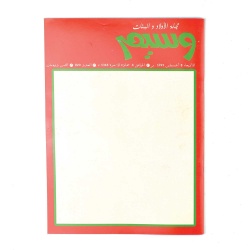 | |
| Author | Francesc Ruiz |
|---|---|
| Language | Arabic |
| Publisher | self-published (free) |
| City | Barcelona |
| Date | 2014 |
| Pages | 32 |
| Format | 29.7 cm x 21 cm |
| Fabrication | Offset |
| E-book | PDF (33 mb) |
In collaboration with Salah Malouli, Wasim 1995 was presented as an installation in MACBA's exhibition Justo delante de nosotros, Otras cartografías del Rif. Its printed version is a collection of thirty-two covers and has all the likes of a children's magazine in Arabic. The covers represent different moments from Morocco's recent history, commemorations and events from the official and religious calendars, such as the Ramadan, the Green March and celebrations of Pan-Arabism, as well as announcements of international contemporary events such as the Mexico Mundial. Although comics and children's literature press coming from France or Belgium were widely read and distributed circa 2005 in Morocco, there was no official or national equivalent to them. By pointing to this little known historical fact and drawing its inspiration from its Franco-Belgian counterparts, Wasim 1995 is a speculative exercise in what Moroccan children’s literature would look like. Ruiz walks a contentious line in mimicking the very violence of capital's market segmentation for the young public and with a sensitive eye, both estranges and provincializes what is taken for granted in western children’s literature.
Commentary: Juan Canela (South as a State of Mind, 2015, EN, [1]).
Tintin Akei Kongo
 | |
| Author | Ilan Manouach |
|---|---|
| Language | Lingala |
| Publisher | MMMNNNRRRG, La Cinquième Couche (40€) |
| City | Lisbon, Brussels |
| Date | 2015 |
| Pages | 64 |
| Format | 22 cm x 16.5 cm |
| Fabrication | Offset |
| E-book | PDF (20 mb) |
"Tintin Akei Kongo is the translated version of Tintin au Congo in Lingala, the official Congolese dialect. The book is an exact facsimile of the commercial edition and follows the industrial standards and layout of classical comics. The goal of this endeavor was not simply to construe the artist’s tasks through a redefinition of the possible interventions by commissioning a translation himself; neither to emphasize the importance of discursivity and self-referentiality as a way to address comics both as a language and a form of logic. The goal is neither to fill a historical error by making this work accessible in the language of those who are primarily interested, the oppressed, the insulted. One should never forget the implicit consensus that stands behind the choice of languages for translated works. The fact that the original edition hasn’t found its way to the African market with a Congolese edition, reminds the reader of Tintin Akei Kongo that distribution of cultural products is not solely governed by profit and market values. Adding Lingala to the 112 different translations of the Tintin Empire, Tintin Akei Kongo reveals blind spots in the expansion of the publishing conglomerates." (from publisher)
Commentary: Dan Nadel (The Comics Journal, 2015, EN), Le dernier des blogs (2015, FR), martalanca (Dá fala, 2015, PT), Uma Bedeteca Anónima (2015, ES), Bill Kartalopoulos (World Literature Today, 2016, EN).
Chronographie
 | |
| Authors | Nikita Fossoul, Dominique Goblet |
|---|---|
| Language | French, English (Introduction & Afterword) |
| Publisher | L'Association (59.75€) |
| City | Paris |
| Date | 2010 |
| Pages | 560 |
| Format | 25.6 cm x 19.6 cm |
| Fabrication | Offset |
| ISBN | 978-2-84414-387-7 |
| E-book | PDF (522 mb) |
Chronographie began with a simple idea: comics artist Dominique Goblet spontaneously proposes to her daughter Nikita Fossoul, then 7, to sit, face to face with her and make portraits of each other. They agree to regularly repeat the experience. This ritual is reproduced almost weekly, and for ten subsequent years. The book, released in the catalogue of L'Association presents a huge body work that chronologically registers the physical and artistic transformations of the two women. Chronographie is a durational performance unfolding entirely in the privacy of the domestic space; its encompassing time span stretching far from what is customary in autobiographical or other works of graphic literature, delivers a narrative of solidarity and care but also a rare glimpse into the process and development of artistic craftsmanship.
Video interview (Fnac, 6 min, 2011, FR).
Reviews: Jessie Bi (du9, 2010, FR), Domingos Isabelinho (The Hooded Utilitarian, 2010, EN), Pilau Daures (du9, 2013, FR).
Muji Life & Yangire/Yandere
 | |
| Author | Hetamoé |
|---|---|
| Language | English |
| Publisher | self-published (Clube do Inferno) (out of stock) |
| City | Lisbon |
| Date | 2015 |
| Pages | 24, 24 |
| Format | 19 cm x 19 cm, 19 cm x 14.5 cm |
| Fabrication | Risograph, B/W laser printing |
| E-book | PDF (21 mb) |
"Muji Life + Yangire/Yandere is a theoretical-practical zine comprising a comic and an essay (respectively), both engaging with the Japanese concepts of yandere (love-struck and psycho) and yangire (cute and psycho). Parodying the look and dimensions of Muji’s catalogue – the Japanese seller of household supplies whose Bauhaus-style minimalism is iconic of an ideal domestic order – Muji Life addresses the underlying connection between madness and method, violence and mundanity, through the eyes of a bloodthirsty “psychotic girl”. Its counterpart, Yangire/Yandere, explores the meaning and (ideological, political) ambivalence of yandere and yangire characters in anime, games and popular culture, including Mirai Nikki, Elfen Lied, Higurashi no Naku Koro ni, Lucky Star, Yandere Simulator and the Sada Abe Incident." (from author)
Terms and Conditions
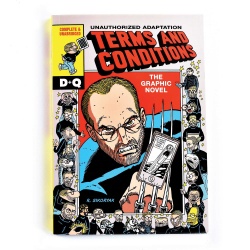 | |
| Author | R. Sikoryak |
|---|---|
| Language | English |
| Publisher | Drawn & Quarterly ($14.95) |
| City | New York |
| Date | 2017 |
| Pages | 108 |
| Format | 17 cm x 24.3 cm |
| Fabrication | Offset |
| ISBN | 978-1-77046-274-8 |
| E-book | PDF (123 mb) |
"For his newest project, Sikoryak tackles the monstrously and infamously dense legal document, iTunes Terms and Conditions, the contract everyone agrees to but no one reads. In a word for word 94-page adaptation, Sikoryak hilariously turns the agreement on its head – each page features an avatar of Apple cofounder and legendary visionary Steve Jobs juxtaposed with a different classic strip such as Mort Walker’s Beatle Bailey, or a contemporary graphic novel such as Craig Thompson’s Blankets or Marjane Satrapi’s Persepolis. Adapting the legalese of the iTunes Terms and Conditions into another medium seems like an unfathomable undertaking, yet Sikoryak creates a surprisingly readable document, far different from its original, purely textual incarnation and thus proving the accessibility and flexibility of comics. When Sikoryak parodies Kate Beaton’s Hark A Vagrant peasant comics with Steve Jobs discussing objectionable material or Homer Simpson as Steve Jobs warning of the penalties of copyright infringement, Terms and Conditions serves as a surreal record of our modern digital age where technology competes with enduringly ironclad mediums." (from publisher)
Reviews: David Barnett (The Independent, 2017, EN), Joe Coscarelli (The New York Times, 2017, EN).
Commentaries: Matt Kamen (Wired, 2017, EN), TCP Staff (Vice, 2017, EN).
978
 | |
| Author | Pascal Matthey |
|---|---|
| Language | French |
| Publisher | La Cinquième Couche (16€) |
| City | Brussels |
| Date | 2013 |
| Pages | 48 |
| Format | 20 cm x 29 cm |
| Fabrication | Offset |
| ISBN | 978-2-9303569-4-5 |
| E-book | PDF (52 mb) |
Matthey works a day job in a Brussels bookstore and judging from his surprising body of work as a comics artist, he is already at ease with more conventional forms of graphic narrative. This book, whose title comes from a prefix that designates, in the numeric ISBN system, the category of objects assigned as books, prefigures something different. 978 took ten years to ferment. It's a narrative work exclusively composed from promotional material circulating in Matthey's workplace that advertises new arrivals of mainstream and epic fantasy comics literature. For many years he collected these pamphlets and painstakingly created a new non-representational, grid-based collage, where each page embodies a different mood. Matthey's selective focus on the physical aspects of the comics industry (its underutilized resources) and the non-remunerative value of its paratextual economy, makes this book the ultimate redemption. 978 is a book "with the sound of its own making", a psychedelic trip that emerges through the interplay between work and leisure, text and context, and writer and reader/user/librarian sensibilities.
Reviews: Jean-Charles Andrieu de Levis (du9, 2014, FR), Pedro Moura (du9, 2014, EN), Pedro Moura (du9, 2014, FR).
La historieta en el (Faulduo) mundo moderno
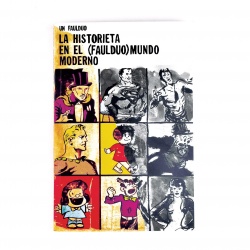 | |
| Author | Un Faulduo |
|---|---|
| Language | Spanish |
| Publisher | Tren en Movimiento (AR$ 490,00) |
| City | Buenos Aires |
| Date | 2015 |
| Pages | 160 |
| Format | 16 cm x 23 cm |
| Fabrication | Offset |
| ISBN | 978-987-3789-10-6 |
| E-book | PDF (72 mb) |
Hailing from Buenos Aires, Un Faulduo is an artists collective which has been investigating, through publications, scholar presentations and performative interventions the different articulations of comics and graphic literature. Here, they revisit Oscar Masotta's legendary research book La historieta en el mundo moderno, originally published in 1970. Masotta's published research on North-American, European and Argentinian comics, as well as the First World Comics Biennial he directed in 1968, were seminal in the medium's history for treating comics as an art form in its own right. Un Faulduo using scans of a rare copy of Masotta's book, recompose the texts with collages, redraw illustrations and materially intervene on Masotta's text. This is a rare example of artistic research in comics, a praxeology proposing to further blur the boundaries between theory and practice. La historieta en el (Faulduo) mundo moderno could be understood as an exercise in perlaboration: a process in psychoanalysis that consists of recognizing and overcoming the resistances (here of the increasingly globalised dimensions of artistic resonance in comics practice) through the repetition, the elaboration and the amplification of an interpretation, that would have certainly appealed to Masotta's inclination for psychoanalysis.
Reviews: Palabras amarillas (2015, ES), Mariano Kairuz (Página12, 2016, ES).
Polyepoxy
 | |
| Author | Bernard Joubert |
|---|---|
| Language | French |
| Publisher | Fondation Paul Cuvelier (16€) |
| City | Brussels |
| Date | 2017 |
| Pages | 92 |
| Format | 17.2 cm x 11 cm |
| Fabrication | Offset, paperback |
| E-book | PDF (24 mb) |
Discussed in the pages of the influential comics reader Eprouvette n° 1 (2006), Polyepoxy, published by the Foundation Paul Cuvelier in Brussels, explores "the most plagiarized comic panel": the manifold unsolicited iterations of a drawing from Cuvelier's Epoxy (1968) depicting a naked Olympia looking behind her shoulder. Bernard Joubert literally leafed through thousands of magazines to document the exact same pose in more than 40 different drawings, particularly in the productions of Italian erotic fumetti, but also elsewhere. Polyepoxy's aesthetics are forensic, with a feel that would have appealed to Lev Manovich's analysis of cultural data or to Franco Moretti's distant reading: the publishers of the book took care to title and date the different findings from the cheaply printed trade paperbacks and reproduce the fragments in the exact size they had been printed. Polyepoxy demonstrates the self-reflexivity of the comic medium and how pervasive swiping practices are in the just-in-time production standards of its economy. It also reflects on how graphic objects move across time and activate different semantic networks only to ultimately confirm the highly gendered nature of the industry's imagination.
360º
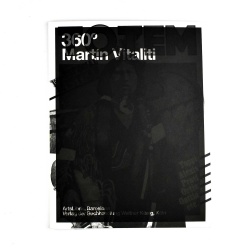 | |
| Author | Martín Vitaliti |
|---|---|
| Language | Spanish (Editor's Note also Catalan/English) |
| Publisher | ArtsLibris (20€) |
| City | Barcelona |
| Date | 2016 |
| Pages | 40 |
| Format | 27 x 21 cm |
| Fabrication | Offset, paperback |
| ISBN | 978-3-86335-943-0 |
| E-book | PDF (36 mb) |
"One could call the artist’s book 360º by Martín Vitaliti (Buenos Aires, 1978, lives in Barcelona) a concept-comic. It is based on a single page from La Banda del Missouri [The Missouri Gang] designed by the acknowledged Italian Hugo Pratt (published in TOTEM EXTRA 20. Especial Western, Editorial Nueva Frontera, Madrid, 1978, p. 91). Its grid of thirteen panels has been reproduced forty-one times while the respective illustrations have been “expanded” by Vitaliti. This results in thirteen panoramic views of each scene throughout the book. The narrative as such — Indians and rangers discovering a riderless horse and a dead body floating in the Missouri river — hasn’t an important meaning. What becomes meaningful is the void of the vast landscape that is developed by Vitaliti’s intervention. He evokes a strange kind of “something in between”, on one hand a visual cinematic effect; on the other hand a frozen storyboard. Compared with other famous panoramic representations of landscapes — think for instance of the Panorama of San Francisco from California Street Hill (1877) by Eadweard Muybridge, or Every Building on the Sunset Strip (1966) by Ed Ruscha — Vitaliti’s approach appears highly complex. What might look as a popular comic book, turned into a Cadavre Exquis, an existing story narrated anew by someone else, that doesn’t develop to a climax but instead remains on hold." (from the editor's note)
Photon
 | |
| Author | Alexis Beauclair |
|---|---|
| Language | French, English |
| Publisher | self-published (Papier Machine) (8€, sold out) |
| City | Saint-Férreol-Trente-Pas |
| Date | 2014 |
| Pages | 8 |
| Format | 18 cm x 26 cm |
| Fabrication | Risograph |
| E-book | PDF (16 mb) |
As described on Beauclair's website, Photon is a narrative experience where the reader enters the optical apparatus through a variety of filters and prisms. Once the end is reached, the reader flips the book only to do the reading in the other direction, and much like a photon she travels back in time. Photon is a beautifully printed visual poem that highlights time and the reading experience as relative quantities.
Compte-rendu des conditions météorologiques
 | |
| Author | Jérôme Puigros-Puigener |
|---|---|
| Language | French |
| Publisher | Habeas Corpus (6€) |
| City | Brussels |
| Date | 2013 |
| Pages | 26 |
| Format | 21 cm x 29.7 cm |
| Fabrication | Xerox, Japanese-style binding |
| E-book | PDF (30 mb) |
Following the practices of conceptual art, the title explicitly mentions the programmatic nature of this work. For two years, Puigros-Puijener observed and registered the weather on a daily basis in the city of Brussels where he lives and, drawing on a weather forecast website, compared it to two different cities for each month such as Alice Springs (Australia) or Biarritz (France). Using weather forecast graphics, a vernacular system of pictogrammatic representation, Puigros-Puijener's work brings to mind Cage's desire to have his music sound like the weather, only here in its digital, mediated, infographic variant.
Negros Rojos
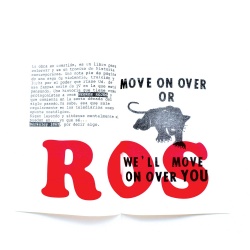 | |
| Author | CCCCC |
|---|---|
| Language | Spanish |
| Publisher | self-published (Fatbottom Books) (10€, out of stock) |
| City | Barcelona |
| Date | 2017 |
| Pages | 21 |
| Format | 25 cm x 34 cm |
| Fabrication | Silkscreen printing |
| E-book | PDF (23 mb) |
CCCCC mocking Barcelona's CCCB's and the institutional acronymic nomenclature, stands for Center for Communication and Conservation of Contemporary Comics. "The work in question is a coloring book, a piece of contemporary history. It's a footnote of a saga of violence, betrayal and fight for the power that you usually laugh at when watching famous TV series. It's a history that started in the sixties...". This is from the introductory text from Negros Rojos; a collection of twenty-one silkscreened posters sealed in an envelope. The project has been presented as a show, and according to CCCCC's spokesperson, "in one of the smallest exhibition spaces in comics history, the bookstore Fat Bottom in Barcelona, further divided by a median wall that could only allow a couple of simultaneous visitors, at most". Negros Rojos presents the findings of a document that was supposedly produced by the Black Panthers for the indoctrination of the young. In reality, it was designed by FBI's Counter Intelligence Program in order to discredit the Black Panthers and mock their revolutionary agenda. Comics has been widely used for propaganda and Negros Rojos traces the bitter history of a comics coloring book that foregrounded the uses of cultural appropriation, overidentification and indoctrination, revealing them as the comics medium's most powerful modes of address.
How to be Everywhere
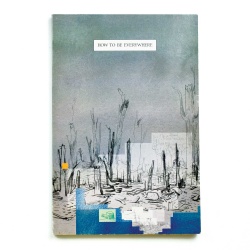 | |
| Author | Warren Craghead III |
|---|---|
| Language | English |
| Publisher | self-published (15€) |
| City | Charlottesville, VA |
| Date | 2007 |
| Pages | 90 |
| Format | 15.2 cm x 23 cm |
| Fabrication | Digital printing |
| E-book | PDF (19 mb) |
How to be Everywhere draws its inspiration from Apollinaire's Calligrames: a literary work that emphasized a playful use of typography and layout as meaningful signifiers in their own right (they would prefigure the more fully experimentations of concrete poetry and poema processo in the 1950s). How to be Everywhere is a highly abstract narrative work that formally explores the interstices between comics and poetry through its elliptical, fragmented and object-oriented storytelling. Evincing all the formal elements that conventionally account for comics making such as panels, speech balloons, characters, genre tropes and other medial modes of address, Craghead's compositions claim - both graphically and in their storytelling structure - a narrative space where text and images are just substructures of the same language.
Rakennusohje
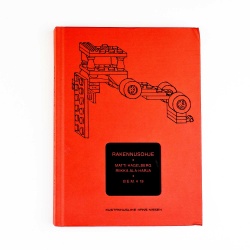 | |
| Authors | Matti Hagelberg, Riikka Ala-Harja |
|---|---|
| Language | Finnish |
| Publisher | Kustannusliike Hans Nissen (25€) |
| City | Lahti |
| Date | 2012 |
| Pages | 112 |
| Format | 15 cm x 20.5 cm |
| Fabrication | Offset, hardcover |
| ISBN | 978-9-52664-600-8 |
| E-book | PDF (84 mb) |
Matti Hagelberg, best known for his dexterity with the scratchboard technique and his ongoing saga Läskimooses, collaborates with writer Riikka Ala-Harja for the making of Rakennusohje. Ala-Harja’s narrative takes place in Normandy and unfolds through a series of disconnected events that can each be described with the conciseness of a title: "The daughter spends the week with her father. The woman visits an American cemetery. A cow gives birth. Eventually the daughter returns home, but she is distant. In the end the two women drive towards Finland. In the end there's a text about Rupert. A parachute mannequin made of cloth which was dropped from the plane during the invasion." Hagelberg's images are inspired by Lego user manuals with their diagrammatic displays that resemble narrative structures in comics grammar. The drawings have a piling effect and their interplay with the text brings in mind what Matthew Kirschenbaum calls rapid shuttling, a reading practice that oscillates between the quantitative display of information and the hermeunetic close reading of the prose.
Scaffold
 | |
| Authors | V. A. Graham, J. A. Eisenhower |
|---|---|
| Language | English |
| Publisher | self-published (Most Ancient) (15€) |
| City | Oakland, CA |
| Date | 2012-2015 |
| Pages | 48 |
| Format | 23.5 cm x 21.6 cm |
| Fabrication | Digital printing, silkscreen covers, handbound |
| E-book | PDF (62 mb) |
Graphically, Scaffold is a strange object. The pages of the series' books are entirely composed of different sets of quasi-architectural formations and various sets of unfolding landscapes mostly depicted frontally. The sequence follows an implicit, oulipian rule that the two artists agreed upon: no world location can ever be revisited or depicted again once it is left. They manifest the artists' desire to produce a system for conveying movement through sets of fixed structures where storytelling, consisting mostly in commonplace dialogues, is just a byproduct of these rigid superstructures. Scaffold reads like a post-human narrative; the reader is left to contemplate something similar to the sidescrolling of a platform video game. No main characters are present. No action takes place. Scaffold thematizes the narrative impact of the background layer. It is a demonstration of comics' intermedial referential capacities in regards to other media, here video games.
RIP
 | |
| Author | François Henninger |
|---|---|
| Language | French |
| Publisher | PCCBA (8€) |
| City | Paris |
| Date | 2017 |
| Pages | 48 |
| Format | 19.5 cm x 29.7 cm |
| Fabrication | Digital printing |
| E-book | PDF (69 mb) |
Henninger takes Alex Raymond's comics strip Rip Kirby for the material of his quasi-sculptural collage experiment. The 48 pages of his self-published RIP exclusively consist of one single page composition of Raymond's comics. Each reproduction of the page comes with paratextual annotations and registers an operation of collage. The pages are xeroxed and the collage operations slowly accumulate, allowing only a few of the recycled materials to carry on. RIP stages the resistance of a morphogenetic narrative to unfold despite the general entropic tendency to degenerate into abstract drawings.
Noirs
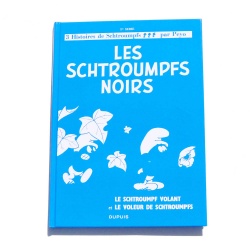 | |
| Author | Ilan Manouach |
|---|---|
| Language | French |
| Publisher | La Cinquième Couche (10€, out of stock) |
| City | Brussels |
| Date | 2014 |
| Pages | 64 |
| Format | 21 cm x 29.7 cm |
| Fabrication | Offset |
| E-book | PDF (13 mb) |
Noirs is a facsimile of the original edition of Les Schtroumpfs Noirs: same cover, same stories, same number of pages, same format, and as close to the original in the quality of paper, weight and so on. There is one, single difference: the four plates of magenta, yellow, cyan and black that form the basis of offset printing have been replaced by four plates of cyan. The goal of this endeavour, apart from reactivating an old consensus and problematizing the innocuously naturalization of the ideological potential of color, was also to shed light on the industrial fabrication of books. Offset printing, a supposedly transparent and mechanic process, once it stops working correctly (here, regarding color separation), can be thoroughly political.
Reviews: Pedro Moura (du9, 2014, EN), Pedro Moura (du9, 2014, FR).
Comics Meetings Artist's Books
 | |
| Author | Francesc Ruiz |
|---|---|
| Language | Spanish |
| Publisher | self-published (Fundació Joan i Pilar Miró a Palma) (free) |
| City | Palma de Mallorca |
| Date | 2013 |
| Pages | 32 |
| Format | 21 cm x 29.7 cm |
| Fabrication | Offset |
| E-book | PDF (43 mb) |
Comics Meetings Artist's Books is a visitor's account of a fictional book fair. Typical of Ruiz's strategy, the project was also presented as an installation at the Fundació Joan i Pilar Miró in Palma de Mallorca. By following the typical guide from illustrated educational literature, the reader gets to visit seven different stands of cutting edge producers of artist's books and independent comics, based in the Mediterranean area. Comics Meetings Artist's Books imagines a world situated at the periphery of the major comics industries (EU-US-JP), where geographical alliances can be activated towards the production of radical artistic scenes and communities. The proverbial figure of the guide is none other than Tiramolla, the famous Italian comics character created by Renzi and Rebuffi in the 1950s. Ruiz's choice for this comic character is not arbitrary. Tiramolla points to a time where the Non-Aligned Movement brought together 120 member-states to articulate an agenda that was independent from the two major political powers during the Cold War era. Comics Meetings Artist's Books, situated far from the medium's superpower geographies, traces an impossible history of comics alliances; the camp aesthetics and secret affinities of the cultural and geographical subaltern of experimental comics producers.
Credits
- Compiled and edited by Ilan Manouach
Ilan Manouach is a musician, a book publisher and a visual artist with a specific interest for conceptual and post-digital comics. He works as a PhD researcher at the Aalto University in Helsinki where he explores materialist practices in experimental comics. He is mostly known for Shapereader, an invented system of tactile communication designed for readers with visual disabilities in regards to the production of comics. His work has been written about in Hyperallergic, New York Magazine, World Literature Today, Wired, e-flux, Le Monde, The Comics Journal, 50 watts and Kenneth Goldsmith’s Wasting Time on the Internet and his books are also part of the Ubuweb online contemporary art archive.